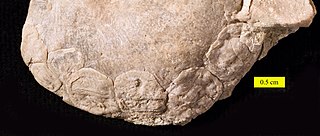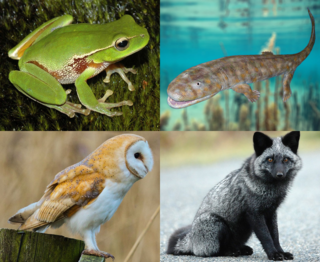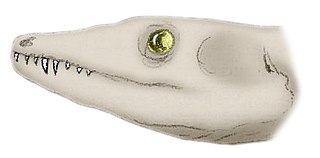
Tetrapods are four-limbed vertebrate animals constituting the superclass Tetrapoda. It includes extant and extinct amphibians, reptiles, and synapsids. Tetrapods evolved from a group of animals known as the Tetrapodomorpha which, in turn, evolved from ancient lobe-finned (sarcopterygian) fish around 390 million years ago in the middle Devonian period; their forms were transitional between lobe-finned fishes and the four-limbed tetrapods. Limbed vertebrates are first known from Middle Devonian trackways, and body fossils became common near the end of the Late Devonian but these were all aquatic. The first crown-tetrapods appeared by the very early Carboniferous, 350 million years ago. The specific aquatic ancestors of the tetrapods and the process by which they colonized Earth's land after emerging from water remains unclear. The change from a body plan for breathing and navigating in water to a body plan enabling the animal to move on land is one of the most profound evolutionary changes known. Tetrapods have numerous anatomical and physiological features that are distinct from their aquatic ancestors. These include the structure of the head for feeding and breathing, limb girdles and digits for locomotion, eyes for seeing, ears for hearing, and the heart and lungs for gas circulation and exchange outside water.

The Caudata are a group of amphibians containing the salamanders (Urodela) and all extinct species of salamander-like amphibians more closely related to salamanders than to frogs. They are typically characterized by a superficially lizard-like appearance, with slender bodies, blunt snouts, short limbs projecting at right angles to the body, and the presence of a tail in both larvae and adults.
The International Code of Phylogenetic Nomenclature, known as the PhyloCode for short, is a formal set of rules governing phylogenetic nomenclature. Its current version is specifically designed to regulate the naming of clades, leaving the governance of species names up to the rank-based nomenclature codes.

Mesosaurs were a group of small aquatic reptiles that lived during the early Permian period, roughly 299 to 270 million years ago. Mesosaurs were the first known aquatic reptiles, having apparently returned to an aquatic lifestyle from more terrestrial ancestors. It is uncertain which and how many terrestrial traits these ancestors displayed; recent research cannot establish with confidence if the first amniotes were fully terrestrial, or only amphibious. Most authors consider mesosaurs to have been aquatic, although adult animals may have been amphibious, rather than completely aquatic, as indicated by their moderate skeletal adaptations to a semiaquatic lifestyle. Similarly, their affinities are uncertain; they may have been among the most basal sauropsids or among the most basal parareptiles.

Anthracosauria is an order of extinct reptile-like amphibians that flourished during the Carboniferous and early Permian periods, although precisely which species are included depends on one's definition of the taxon. "Anthracosauria" is sometimes used to refer to all tetrapods more closely related to amniotes such as reptiles, mammals, and birds, than to lissamphibians such as frogs and salamanders. An equivalent term to this definition would be Reptiliomorpha. Anthracosauria has also been used to refer to a smaller group of large, crocodilian-like aquatic tetrapods also known as embolomeres.

Haptodus is an extinct genus of basal sphenacodont, member of the clade that includes therapsids and hence, mammals. It was at least 1.5 metres (5 ft) in length. It lived in present-day France during the Early Permian. It was a medium-sized predator, feeding on insects and small vertebrates.

Mesosaurus is an extinct genus of reptile from the Early Permian of southern Africa and South America. Along with it, the genera Brazilosaurus and Stereosternum, it is a member of the family Mesosauridae and the order Mesosauria. Mesosaurus was long thought to have been one of the first marine reptiles, although new data suggests that at least those of Uruguay inhabited a hypersaline water body, rather than a typical marine environment. In any case, it had many adaptations to a fully aquatic lifestyle. It is usually considered to have been anapsid, although Friedrich von Huene considered it to be a synapsid, and this hypothesis has been revived recently.

The Craniidae are a family of brachiopods, commonly known as lamp shells. Although it belongs to a subdivision called the inarticulata which have shells where the mineral content consist of calcium phosphate, the Craniidae have shells that consist of calcium carbonate. Other special characteristics of this family are that no outgrowths are developed to form a hinge between both valves, nor is there any support for the lophophore. As adults, craniids either lived free on the ocean floor or, more commonly, were attached to a hard object with all or part of the ventral valve. In craniids, a pedicle is not known from any development stage.
Paleontology or palaeontology is the study of prehistoric life forms on Earth through the examination of plant and animal fossils. This includes the study of body fossils, tracks (ichnites), burrows, cast-off parts, fossilised feces (coprolites), palynomorphs and chemical residues. Because humans have encountered fossils for millennia, paleontology has a long history both before and after becoming formalized as a science. This article records significant discoveries and events related to paleontology that occurred or were published in the year 1991.

Iberospondylus is an extinct genus of basal temnospondyl amphibian which lived in a marine environment. The type material was found in the Emma Quarry Amphibian Bed of the Puertollano Basin, Ciudad Real province, southern Spain and extended the record for temnospondyls on the peninsula by 45 million years. Along with the holotype, a skull with several disarticulated vertebrae and ribs, two other partial skeletons are known. The name is derived from "Iberia" name of the peninsula where Spain is located, plus "spodylos", Greek for vertebra. The species name is in honor of Dr. Hans-Peter Schultze.

Stegocephali is a group containing all four-limbed vertebrates. It is equivalent to a broad definition of Tetrapoda: under this broad definition, the term "tetrapod" applies to any animal descended from the first vertebrate with limbs and toes, rather than fins. This includes both the modern lineage of limbed vertebrates as well as a portion of the stem group, limbed vertebrates that evolved prior to the origin of the crown group. Members of the tetrapod stem group include the earliest limbed tetrapodomorphs such as Ichthyostega and Acanthostega, which evolved in the Devonian Period long before any modern form of tetrapod.
"Haptodus" garnettensis is an extinct species of basal sphenacodont from the Late Carboniferous (Pennsylvanian) of Kansas, USA.

The Army of Free Lebanon – AFL or "Colonel Barakat's Army", also designated Armée du Liban Libre (ALL) and Armée du Colonel Barakat in French, was a predominantly Christian splinter faction of the Lebanese Army that came to play a major role in the 1975–77 phase of the Lebanese Civil War.

Apsisaurus is an extinct genus of Early Permian varanopid synapsids known from Texas of the United States. It was first named by Michel Laurin in 1991 and the type species is Apsisaurus witteri. Apsisaurus witteri is known from the holotype MCZ 1474, a three-dimensionally preserved partial skeleton including an incomplete skull and mandibles. The skull roof of Archeria is also articulated to the postcranial skeleton. It was collected in the Archer City Bonebed 1 site, from the Archer City Formation of the Wichita Group, dating to the Early Permian epoch. Apsisaurus was formerly assigned as an "eosuchian" diapsid. In 2010, it was redescribed by Robert R. Reisz, Michel Laurin and David Marjanović; their phylogenetic analysis found it to be a basal varanopid synapsid.

Cutleria is an extinct genus of basal sphenacodontids or derived stem-sphenacodontoid known from the Early Permian period of the Colorado, United States. It contains a single species, Cutleria wilmarthi.

The Lebanese Arab Army – LAA, also known as the Arab Army of Lebanon (AAL), Arab Lebanese Army or Armée du Liban Arabe (ALA) in French, was a predominantly Muslim splinter faction of the Lebanese Army that came to play a key role in the 1975–77 phase of the Lebanese Civil War.
Rachel Laurin is a Canadian organist, composer and music educator living in Quebec.
The following is a taxonomy of extant (living) Brachiopoda by Emig, Bitner & Álvarez (2019). There are over 400 living species and over 120 living genera of brachiopods classified within 3 classes and 5 orders, listed below. Extinct groups are not listed.












